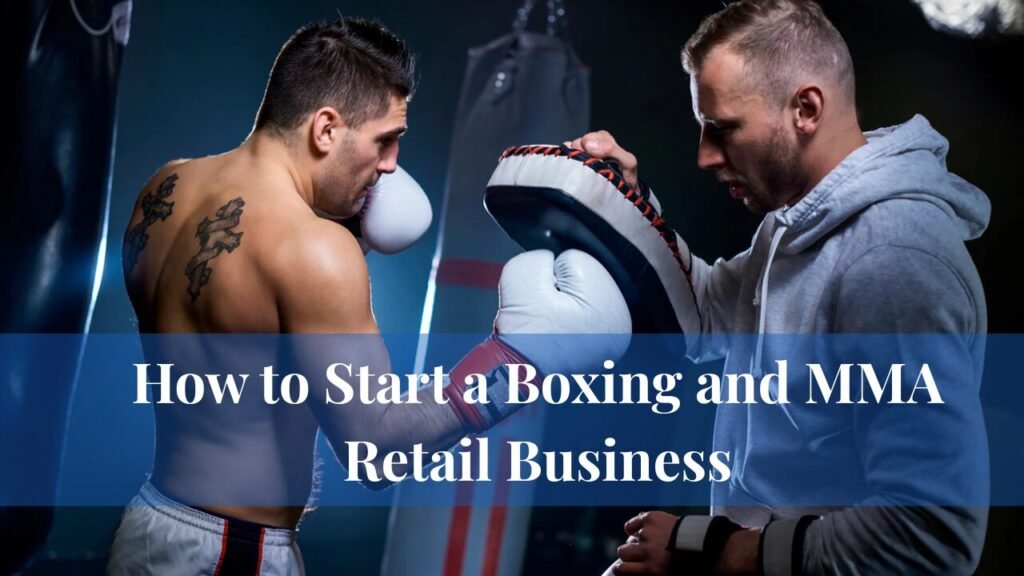Starting a boxing and MMA retail business can be a highly profitable venture if executed correctly. With the fitness industry booming and combat sports becoming increasingly popular, now is a great time to enter the market. Whether you are looking to open a physical store or launch an online shop, this guide will walk you through every essential step while ensuring you position yourself as a trusted authority in the industry.
Why Start a Boxing and MMA Retail Business?
The global combat sports industry has witnessed exponential growth over the past few years, and this momentum continues to build. According to Statista, the global sports equipment market is projected to reach over $200 billion by 2025, with a significant portion driven by boxing and MMA gear. This figure highlights not only the profitability of the industry but also its potential for long-term sustainability.
Starting your own retail business in this niche taps into a passionate and loyal customer base. Boxing and MMA athletes, fitness enthusiasts, and recreational practitioners often require high-quality equipment for safety, performance, and training efficiency. By entering this market, you are not only selling products but also helping people achieve their health, fitness, and competitive goals. For entrepreneurs with a strong interest in sports, this venture combines passion with business growth opportunities, offering the best of both worlds.
Market Potential and Trends
Combat sports are no longer confined to professional athletes. Today, people from all walks of life are engaging in boxing and MMA for diverse reasons such as weight loss, self-defense, personal discipline, and overall fitness. Teenagers, young adults, and even professionals in corporate environments are turning to these sports as an outlet for stress relief and physical development.
This expansion of the consumer base opens up demand for specialized gear. Women’s MMA gloves, youth-sized boxing gloves, beginner-friendly punching bags, and home workout kits are rapidly growing segments. The popularity of boutique fitness studios, home training programs, and YouTube workout tutorials is further fueling interest. In addition, trends such as boxing-inspired group classes, MMA-based HIIT sessions, and fitness influencers showcasing gear online are creating new marketing opportunities for retailers.
By recognizing these shifts and catering to them through unique product offerings, you can position your store as an innovative and trustworthy choice. Providing expertise-driven recommendations, for example by publishing guides on selecting the right gloves for beginners or the ideal mouthguard for sparring, can help your business stand out as a reliable authority in the industry.
Step-by-Step Guide to Launching Your Business
Research the Market
Before investing your hard-earned money, it is crucial to understand the competitive landscape and your target audience. Research should focus on who your customers are, what products they are buying, and how they prefer to shop. For instance, younger audiences might prefer purchasing through mobile devices, while professional fighters might prefer in-store trials before making decisions.
Competitor analysis is equally important. Reviewing other stores’ pricing, customer reviews, and overall branding can reveal gaps in the market. If most stores focus on general gear, you could differentiate yourself by offering personalized, custom-fit gloves or specialized training bundles. Tools such as Google Trends, SEMrush, and social media analytics can highlight emerging keywords and products gaining traction. Pair this data with real-world insights from local gyms, trainers, and fitness communities to understand customer pain points firsthand.
Choose Your Business Model
Once you know your audience, you need to decide how you will operate. A brick-and-mortar store allows customers to physically test equipment, which builds trust and community engagement. An online store, on the other hand, provides a global reach at a fraction of the cost. Many modern entrepreneurs opt for a hybrid model that combines the strengths of both approaches.
For example, an online platform could serve international buyers, while a small local showroom near a gym could allow hands-on product experiences. The choice depends on your financial resources, competition in your area, and long-term vision for scalability.
Legal Structure and Licensing
Compliance with legal and financial regulations is essential to build credibility and avoid setbacks. Choosing the right legal structure, whether it is a sole proprietorship, partnership, or limited liability company (LLC), impacts everything from taxation to liability protection. You will also need to register your business name, obtain a Federal EIN (Employer Identification Number), and secure the necessary local licenses and permits.
Because boxing and MMA involve high-contact equipment, product liability insurance is highly recommended. This protects you in case of injuries related to equipment use. Consulting with a local attorney or business advisor ensures you meet all regional laws, creating a trustworthy foundation for your business.
Build Your Brand
A strong brand establishes authority and builds lasting customer trust. Your business name should be short, memorable, and clearly tied to combat sports. A professional logo and color palette can further reinforce your credibility. Beyond aesthetics, storytelling is vital. Customers connect with authentic stories, so sharing your journey—whether it is your background as an athlete, your passion for fitness, or your mission to provide safe and affordable gear—helps strengthen brand loyalty.
Developing a robust online presence is equally important. Secure a domain name, optimize your website for SEO, and maintain active social media channels. Platforms like Instagram and TikTok are particularly effective in this niche, as users engage with visual demonstrations of products. Incorporating customer testimonials and success stories adds an extra layer of trustworthiness, demonstrating that your products deliver real-world value.
Source Your Inventory
Inventory sourcing can make or break your business. The most important consideration is quality. Combat sports gear is used in high-intensity environments, and poor-quality equipment can lead to injuries. Partnering with reliable suppliers ensures consistency and safety. Attending trade shows such as ISPO or martial arts expos helps build direct relationships with manufacturers, giving you an edge in pricing and exclusive product offerings.
Decide whether you want to wholesale, dropship, or develop private-label products. Each method has different costs, risks, and profit margins. For example, dropshipping lowers upfront investment but reduces control over shipping timelines. Private labeling requires more capital but allows you to create a unique product line with your brand name, giving you stronger authority in the market.
Set Up Your Store
For a physical store, location is critical. Being near gyms, training centers, or busy commercial zones can increase visibility. The store layout should make it easy for customers to navigate categories such as gloves, apparel, and accessories. Interactive spaces where customers can test products add credibility and improve trust.
For online stores, platforms like Shopify or WooCommerce provide professional, mobile-responsive templates. Integrating fast shipping options, responsive customer support, and clear product descriptions builds confidence. Offering features like product demo videos or size guides also enhances user experience, ensuring buyers feel secure in their purchases.
Pricing Strategy
Pricing should balance profitability and customer trust. Transparent pricing structures, seasonal promotions, and loyalty programs can encourage repeat purchases. Offering tiered product ranges for beginners, intermediates, and professionals shows your expertise in catering to all levels of athletes. A clear return policy is equally crucial for building trust, as it reassures customers about their investment.
Marketing and Promotion
Marketing is where your authority and expertise truly shine. Content marketing, such as blogs on boxing training tips or equipment comparisons, positions your brand as a knowledgeable source. Search engine optimization ensures that potential customers can find you when searching for relevant terms like “best boxing gloves for beginners.”
Social media marketing is particularly powerful in combat sports. Partnering with influencers, trainers, or even local gyms can amplify your reach. User-generated content, such as customers posting photos of your gear in action, further strengthens credibility. Paid ads on Google or Meta platforms can drive targeted traffic, while email newsletters nurture long-term relationships.
Highlighting positive reviews is also essential. For example, if your store is rated highly on Google Reviews, showcasing those ratings establishes instant trust.
Budget and Cost Breakdown
The financial aspect of your business requires careful planning. Startup costs typically include inventory, website development, store rent, utilities, marketing, licensing, insurance, and branding. While initial investment can range widely, starting with an online store often reduces expenses significantly.
To save costs, consider strategies such as partnering with local gyms for cross-promotion, hiring freelancers for design or content, or using print-on-demand services for apparel. These methods allow you to maintain professionalism without overextending your budget.
Managing Logistics and Operations
Efficient operations ensure customer satisfaction and long-term growth. Using cloud-based inventory tools helps prevent stockouts, while reliable shipping carriers improve customer trust. Clear return and refund policies reassure customers that they are purchasing from a trustworthy brand.
As your business scales, third-party logistics (3PL) solutions can handle warehousing and shipping, allowing you to focus on marketing and growth. A dedicated customer support system, complete with FAQs, live chat, and fast response times, builds stronger relationships with your audience.
Analytics and Improvement
Growth depends on constant evaluation and refinement. Using tools like Google Analytics provides insights into customer behavior, helping you optimize product pages and marketing campaigns. A/B testing for promotions, email subject lines, or website layouts can reveal what resonates most with your audience. Tracking key performance indicators such as conversion rates, return rates, and customer lifetime value ensures you stay aligned with your long-term goals.
FAQs
What licenses do I need to start a boxing/MMA retail store?
You’ll typically need a business license, EIN, and a sales tax permit. Check your local state requirements.
Is it better to start online or offline?
Online is often more cost-effective to start, but combining both offers the best reach and customer experience.
What are the most profitable items to sell?
Gloves, apparel, and accessories like hand wraps, mouthguards, and punching bags have high demand.
Can I start the business with a small budget?
Yes, starting online with limited inventory or dropshipping can keep costs under $5,000.
Conclusion
Starting a boxing and MMA retail business requires planning, passion, and persistence. By researching your market, offering quality equipment, and building a trustworthy brand, you can create a business that not only generates profit but also serves a growing community of combat sports enthusiasts.
Focusing on long-term credibility through exceptional customer service, transparent policies, and SEO-driven marketing ensures sustainable success. Whether online or offline, your ability to stay consistent, refine strategies, and build meaningful connections with customers will determine how far your brand goes in this competitive industry.
If you want to learn more about boxing and explore additional resources, visit Boxing Essential.




